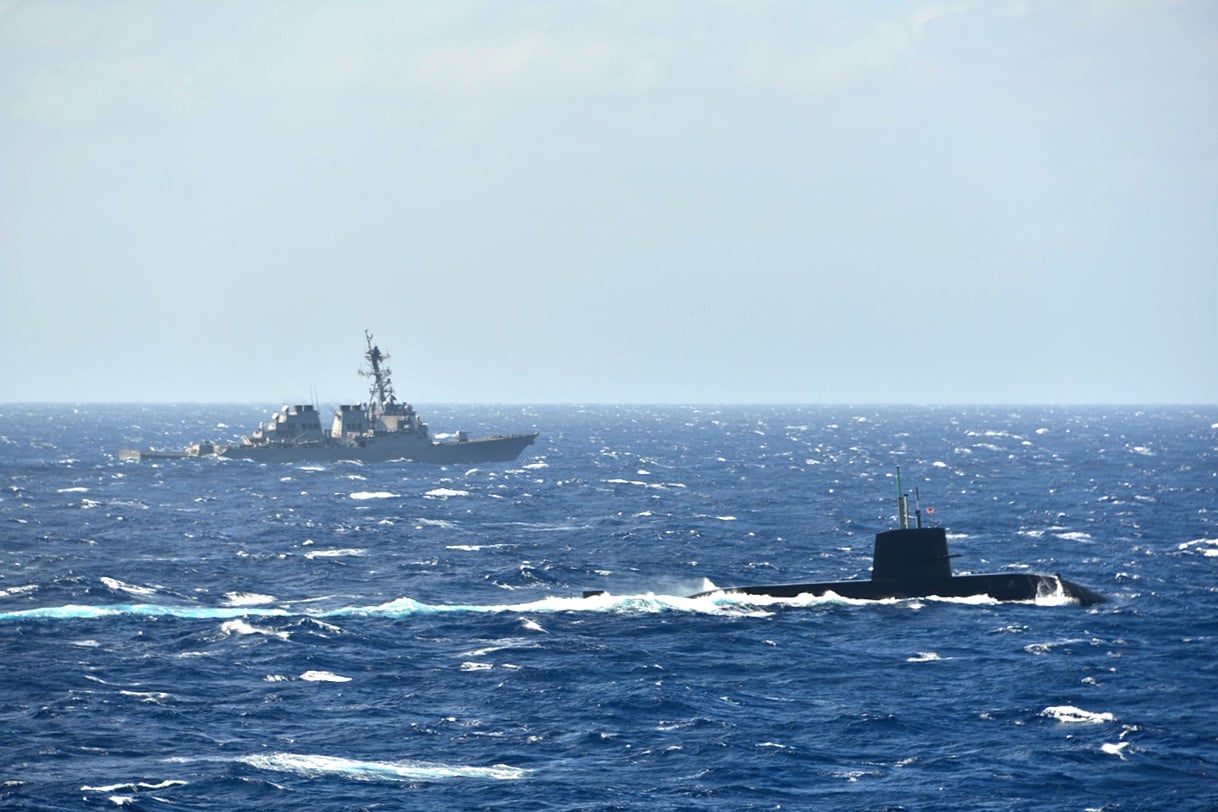
KUALA LUMPUR – Japanese and U.S. fleets met this week for a first-ever anti-submarine warfare exercise in the South China Sea, the Japan Maritime Self-Defense Force said today.
Helicopter destroyer JS Kaga (DDH-184) and destroyer JS Murasame (DD101) with their embarked SH-60J helicopters, an unnamed Oyashio-class submarine and a P-1 Maritime Patrol aircraft conducted an anti-submarine warfare exercise in the South China Sea with U.S. Navy destroyer USS Milius (DDG-69) and a U.S. Navy P-8A maritime patrol aircraft on Tuesday.
This is the first time a JMSDF submarine conducted an anti-submarine warfare exercise with the U.S. Navy in the South China Sea. Both Kaga and Murasame had conducted an exercise in the South China Sea with Milius last week and subsequently made a port call in Subic, the Philippines over the weekend. Upon departure from Subic, the ships conducted an exercise in the South China Sea with Philippine Navy frigate BRP Jose Rizal (FF-150).
Japan’s Indo-Pacific Deployment 2021 (IPD21) task group left in late August and is scheduled to return to Japan by Nov. 25. The task group also includes destroyer JS Shiranui (DD 120), but Shiranui, like the Oyashio-class submarine, has largely been operating separately from Kaga and Murasame and only joining the other two ships on specific exercises.
The JMSDF issued two news releases on exercises soon taking place in Japan. The first release, issued on Nov. 9, announced that the JMSDF will carry out both an in-house mine warfare exercise and a bilateral mine warfare exercise with the U.S. Navy from Nov. 18 through 28 in the Hyuga Nada Sea off Kyushu. The bilateral exercises will involve 17 JMSDF minesweepers, one minesweeper tender and two JMSDF MCH-101 Mine Counter Measure (MCM) helicopters, while the U.S. Navy will deploy 2 MCM ships along with two MH-53E helicopters.
The second release, issued on Tuesday, announced that from Nov. 21 to 30 in the waters around Japan, a bilateral naval exercise between the JMSDF and the U.S. Navy will take place, along with two multilateral exercises. The first multilateral drill will include the JMSDF, U.S. Navy, the Royal Australian Navy and the German Navy, while the second involves the JMSDF, U.S. Navy, RAN and the Royal Canadian Navy. A total of 20 JMSDF ships and 40 JMSDF aircraft, 10 U.S. Navy ships, two RAN ships, a single RCN ship and a single German Navy ship will take part in these drills.
Currently, RAN frigate HMAS Warramunga (FFH152) and German Navy frigate FGS Bayern (F217) are on monitoring and surveillance patrols in the East China Sea in support of United Nations sanctions on North Korea, while Canada’s HMCS Winnipeg (FFH338) is on a presence deployment to the region and currently on a port visit at White Beach Naval Facility Okinawa. RAN destroyer HMAS Brisbane (D41) is also currently near Japan.
Meanwhile, the U.S. Navy on Monday began the Cooperation Afloat Readiness and Training (CARAT) Brunei exercise, which is taking place both in the South China Sea and virtually. U.S. Navy assets participating in the five-day engagement include USS Jackson (LCS-6) and a P-8A Poseidon aircraft, as well as sailors from Special Operations Command Pacific, Naval Special Warfare Command, Special Boat Teams and members of the U.S. Coast Guard.

The exercise focuses on the full spectrum of naval capabilities and features cooperative evolutions that highlight the ability of U.S. and Brunei to work together towards the common goal of ensuring a free and open Indo-Pacific maritime security environment, according to a U.S. 7th Fleet news release.
“As the 27th iteration of the CARAT exercise series, 2021 underscores the longstanding role of CARAT to address shared maritime security interests amongst partner navies,” Capt. Tom Ogden, the commodore of Destroyer Squadron (DESRON) 7, said in the release.
Brunei and the U.S. will carry out the at-sea portion of the drills in the South China Sea, according to 7th Fleet.
“During the sea-phase of the exercise, both countries will demonstrate their ability to work together through numerous events including divisional tactics designed to enhance communication as ships sail together in complex maneuvers, a tracking exercise aimed at increasing both navies’ ability to track and pursue targets through the coordinated deployment of surface ships and maritime patrol aircrafts, and search and rescue exercises,” the news release reads.
Earlier, the U.S. Navy conducted the CARAT Indonesia exercise virtually, in Surabaya and in the waters and airspace of the Java Sea from Nov. 1 through 11. U.S. Navy assets taking part in the exercise were Jackson, Expeditionary Fast Transport ship USNS Millinocket (T-EPF 3) and a P-8A Poseidon. Indonesian Navy ships taking part in the exercise were the Indonesian Navy frigate KRI I Gusti Ngurah Rai (332), corvette KRI Diponegoro (365) and fast patrol boat KRI Ajak (653).
Meanwhile, over in Manila, the Russian Navy corvette Gremyashchiy (337), submarines Petropavlovsk-Kamchatsky (B274) and Volkhov (B603), tanker Pechenga, and tug Alatau pulled into port on Nov. 16 for a replenishment visit. The corvette and submarines were previously part of the Russian Navy’s Baltic Fleet and are now en-route to their new home bases as part of Russia’s Pacific Fleet. A Russian Ministry of Defense news release said Manila will be the last foreign port the ships will call on during the voyage to their new home base.





